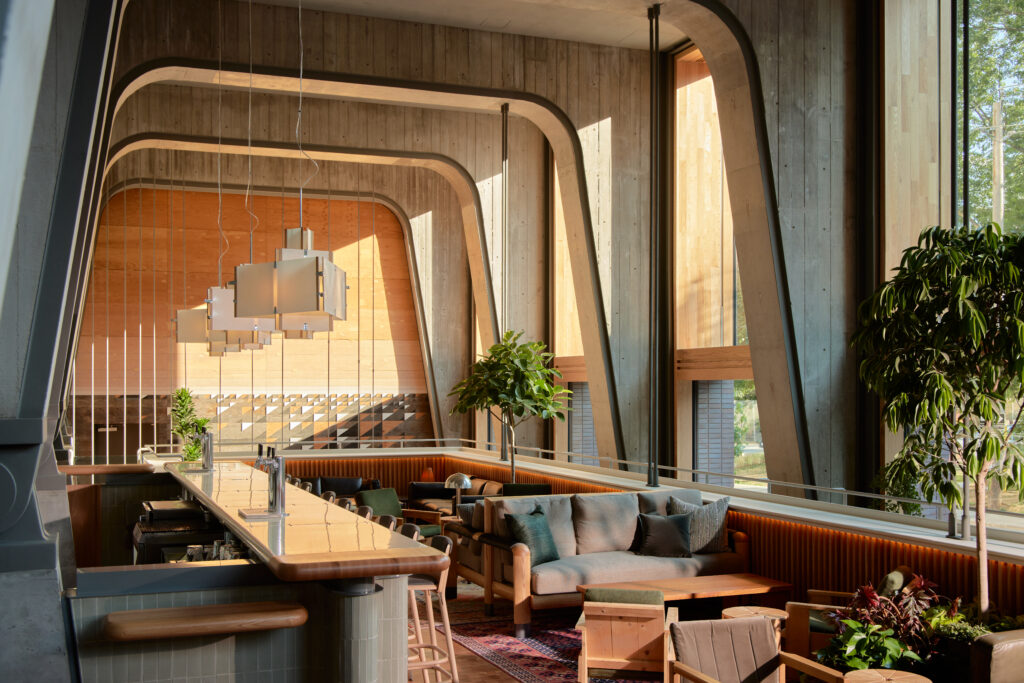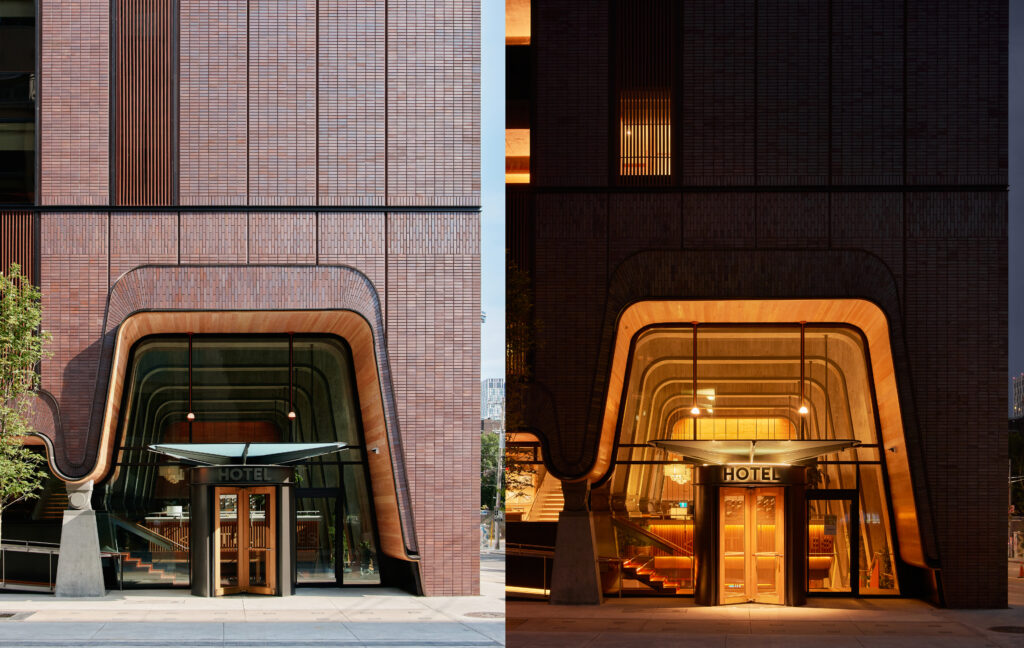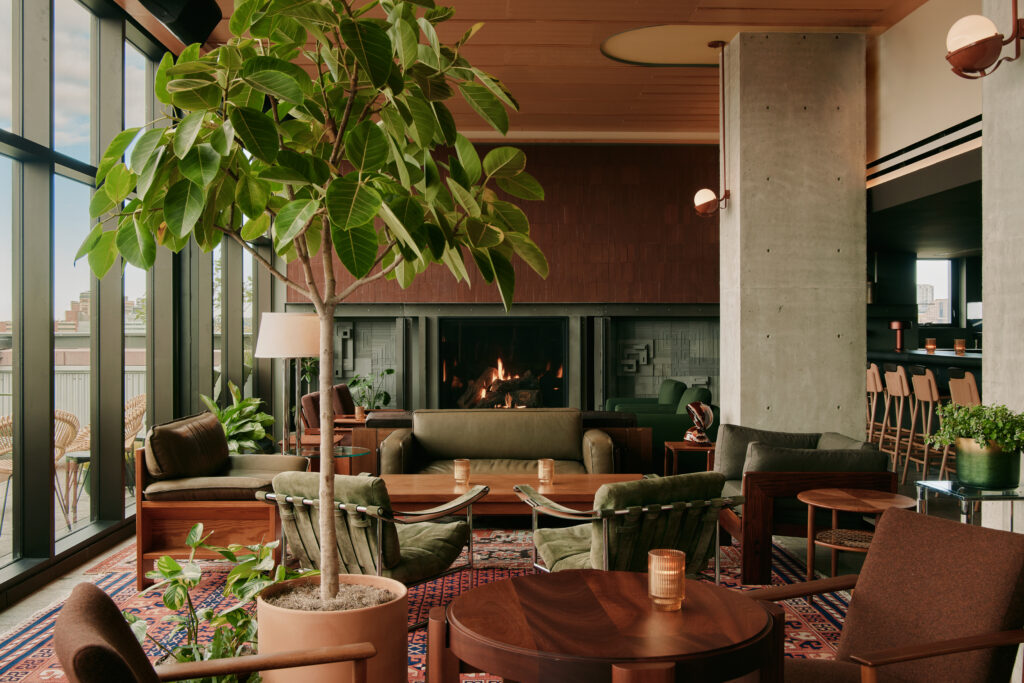The Ace Hotel Toronto, a Third Place Reimagined
Step through the lobby at Ace Hotel Toronto’s ground-level entrance on Camden Street and you’ll likely notice something unexpected. This isn’t a quiet, pass-through lobby or a hushed guest-only zone. Instead, it’s buzzing with laptops open, espresso cups clinking, conversations flowing, playlists humming.
In Toronto’s growing ecosystem of third places, The lobby at Ace Hotel stands out, not because of its exclusivity, but because of its accessibility. It’s a space that invites you in, encourages you to stay, and makes no assumptions about why you’ve come. And in a city that’s increasingly vertical, digital, and siloed, that kind of invitation is rare.
What Makes a Third Place Work?
Sociologist Ray Oldenburg coined the term “third place” to describe the social spaces that exist between home and work: informal, neutral, and accessible environments that foster connection and community. Think cafés, barber shops, parks, and bookstores.
Today, the concept has expanded to include lobbies, lounges, cafés, and creative spaces. As long as they provide what people increasingly crave: comfort without conditions, structure without rigidity, and the chance to be around others without needing a reason. A third place doesn’t demand productivity or performance. It simply allows presence. At Ace Toronto, that presence is both designed and felt.
The Lobby at Ace Hotel Toronto: Designed to Welcome Everyone

The design of the lobby draws openness at every turn, from its architecture to its flow of movement. Drawing from the ethos of the broader Ace Hotel brand, the Toronto location, designed by Shim-Sutcliffe Architects, is a seamless blend of heritage structure and modern intimacy. You’re met with exposed concrete and Douglas fir detailing, softened by layered lighting and carefully selected textiles. There’s a distinct spatial rhythm: raw industrial edges contrasted with deep leather sofas, textured rugs, and bookshelves curated with art, architecture, and local culture titles.
Natural light pours through floor to ceiling windows during the day, giving the space a quiet luminosity, while in the evening, soft pendants and corner sconces take over, casting golden glows across conversations. There’s no reception counter in the center of the room to remind you that this is a hotel. Only tables, couches, and the hum of city life in retreat.
What makes this design special isn’t just how it looks, but how it feels. Every angle is considered not just for aesthetics but for interaction: eye lines, seating height, acoustic absorption. The result is a room where people feel encouraged to stay, whether they’re with friends or in solitude.
Coffee as a Cultural Connector
What anchors all of this? Coffee, of course.
At Ace, coffee becomes a subtle form of invitation. It’s an understated gesture that connects guests and locals alike. The barista bar invites passersby off the sidewalk and gives hotel guests a reason to come downstairs. Coffee provides just enough structure to make the space feel purposeful, without forcing a time limit.
Whether you’re meeting a friend, working remotely, waiting for a dinner reservation, or reading solo for an hour, it’s the cup in your hand that makes your presence feel at home.
The Day-Part Effect: Why Ace Hotel Toronto Works Morning to Night

Ace’s strength lies in its ability to transform throughout the day, shifting naturally to suit different rhythms and moods. Mornings begin in a hush: freelancers with laptops settle into corner seats, teams huddle for coffee-fueled brainstorms, and hotel guests quietly leaf through books or catch up on emails. The light is soft and natural, and the music barely hums beneath the clinking of ceramic.
By early afternoon, the lobby shifts. It becomes a crossover zone: part café, part casual meeting space, part cultural salon. You might overhear teams meeting, creative consultants reviewing decks, or friends spontaneously running into each other. It’s a social engine running at low speed, never hurried, but always alive.
Then comes evening. The playlist gets bolder, the bar comes to life, and the space morphs again. Candlelight flickers along the bar and tabletops. Cocktails replace coffee. And for those looking to extend the moment further, the rooftop bar, Evangeline, upstairs opens its doors offering panoramic views, a refined drinks list, and an elevated sense of place.

The Ace Hotel Toronto welcomes you in with ease and leaves you wanting to return, no matter the hour.
The City Needs Places Like the Ace Hotel Toronto
Ace isn’t the only place doing this well—but it’s one of the most visible examples. For a broader look at how cafés and communal interiors across the city are evolving into shared cultural spaces, see our companion feature: Toronto’s Third Places: Where Coffee Meets Community. As third places gain new importance in dense urban settings, the Ace lobby acts as a case study for what happens when hospitality, design, and community are intentionally layered.
Toronto is in the middle of an urban shift, toward denser housing, hybrid work, and increasingly blurred lines between personal and professional life. Places like the lobby at Ace Hotel respond to that shift not with tech or transactional features, but with something simpler: thoughtfully designed space that welcomes everyone.
So whether you’re checking in, checking email, or just checking out for a while, The Ace Hotel Toronto is ready for you. No reservation required.
